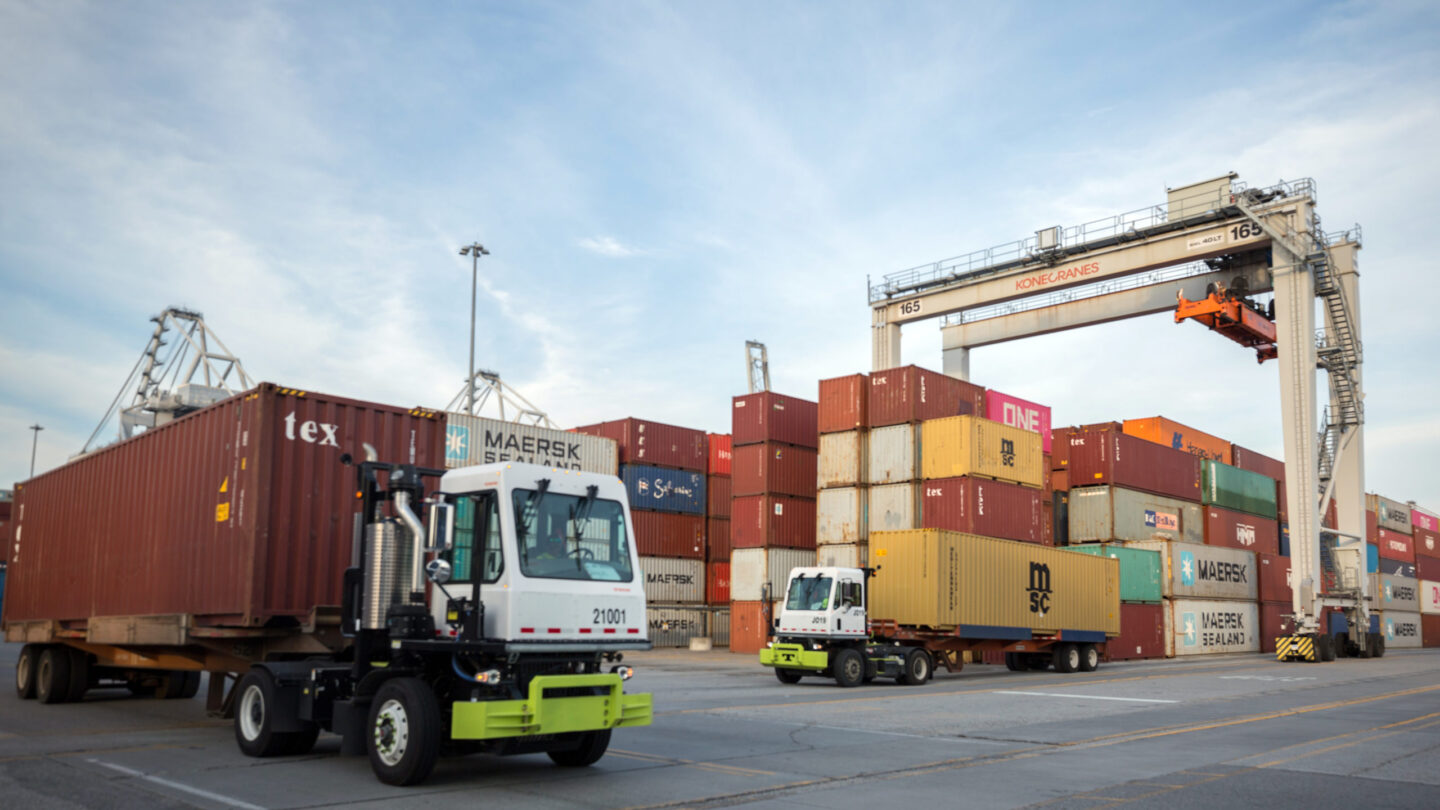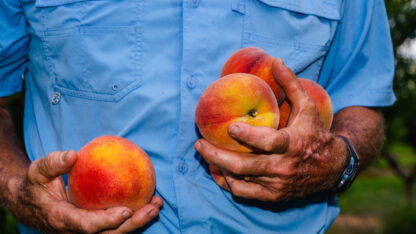This story was updated on June 30.
Arborist Mike Pavlis spent a recent morning walking around a couple of large properties in Savannah that are slated for development. Right now, they’re home to some houses, a coop with chickens and turkeys and a lot of trees.
Pavlis was looking for what are known as significant trees.
“This is an elm tree,” he said, stopping to measure its trunk and tag its GPS coordinates. “This one here is going to qualify for size alone.”
Pavlis works as a contractor, evaluating the trees on land where someone wants to build. The rules vary from city to city, but generally, if developers cut down a healthy significant tree like this elm, they have to pay into a fund that cities use to plant and maintain trees.
While saving and planting new trees has long been a pet project for environmental activists, the trees in western Chatham County have become a serious area of concern as new warehouses pop up to support the ever-growing Port of Savannah.
“This is an issue of quality of life, and public health, and really just making sure that everybody has the same access to green space,” said Zoe Rinker, executive director of the Savannah Tree Foundation.
That’s because trees aren’t just pretty to look at. They’re a great noise buffer. They create shade that cools the area down — essential as climate change makes temperatures hotter for more of the year. They also soak up water, a key to preventing floods from heavy rainfall, another impact of climate change.
And trees help fight climate change itself — they’re great at absorbing carbon dioxide from the air.
A rapidly growing port
The Port of Savannah is the fourth busiest in the country, moving more and more cargo all the time. And all that stuff — whether it’s things Georgians need, or goods made here and headed overseas — needs somewhere to go.
“You’ve got to have an opportunity or a spot to take it off the container, repackage it, send it to all the other locations that you know where the ultimate product is supposed to end up,” said Trip Tollison, president and CEO of the Savannah Economic Development Authority.
And to avoid delays at the port, all of that has to be done quickly. To keep up, the region has gone from 20 million square feet of warehouse space in 2005 to more than 80 million square feet now. Another 18 million square feet is underway.
The Georgia Ports Authority credits this vast and growing warehouse space, along with quick nearby connections to highways and rail lines, for its ability to keep ships moving in and out of the harbor and avoid the long shipping delays that have plagued other ports.
Between the port itself and related industries like warehousing, trucking and manufacturing, the Georgia Ports Authority says it helps support nearly 46,000 jobs in Chatham County.
And the jobs at the new warehouses pay well, Tollison said.
“We’re seeing $22, $23 an hour right now in the market,” he said. “There’s been a really steady rise in what folks are paying in the logistics industry.”
Companies and communities step up
But as warehousing grows, more and more trees are lost.
“It’s mostly forested area that is being sold and cleared for the purposes of creating the infrastructure to support our trucking and ports industries,” Rinker said.
In 2020 alone, Rinker said Chatham County lost 250 forested acres to industrial construction. And construction has increased since.
Pavlis said some developers see the benefits of preserving trees on their properties.
Working with an arborist like him, a developer can adjust the plans for a site. Rather than cut down a large, established tree, for instance, the company could move the warehouse footprint slightly to avoid the tree and locate employee parking in the tree’s shade.
And, Pavlis said, saving a tree can be good PR.
“Everybody likes good press, especially when the community, like Savannah, is so pro-tree,” he said. “Showing people that you’re caring for trees as much as possible helps long-term. The next project that you do develop and they see your name on the board, they’ll know that you’re pro-tree.”
It varies from developer to developer, Pavlis said. Some are happy to save trees, while others just want to maximize warehouse space.
“I think money kind of has a little bit to do with it,” he said. “But it’s also personal stake, because there are developers out there, not all of them are bad. A lot of them care.”
That’s what Tyrone Ware has banked on for years. He’s the neighborhood association president in Woodville, a mostly-Black community on the west side of Savannah that was founded shortly after the Civil War. Today, Woodville is surrounded by railroad tracks, truck routes, industrial plants and the Port of Savannah’s new Ocean Terminal.
“We’ve always had a history of being proactive,” Ware said. “And as industry grew up around the community, there were more needs to protect ourselves, with the ports expanding, with industry expanding all the way around us.”
Even surrounded by industry, Ware said Woodville has thrived as a residential neighborhood, where many families have lived for generations, new houses are being built, and property values are increasing.
Ware said they’ve managed this by approaching the companies that surround them as neighbors, not enemies.
“It’s a matter of them being conscientious and understanding that the community has been here, the community wants to be here, and that they want to work with us and want to be partners and neighbors with us,” he said.
It’s worked well, Ware said. In one case, a company chose to double the wooded space required by law between its facility and the nearby houses.
But the neighborhood doesn’t just trust companies to do the right thing. They work with colleges and other experts so they’ve got data to back up what they’re asking for.
Ware said other neighborhoods with industry next door can learn from this approach.
Governments strive for balance
There’s only so much individual neighborhoods can do to mitigate the risks they face from growing industrial activity, though. Local governments are also working to strike the right balance between industry and their residents.
While most of the cities in Chatham County, and the county itself, have ordinances designed to protect their trees, Rinker said those laws were mostly written in the 1990s — long before the current warehouse boom.
“Our tree ordinance wasn’t necessarily made [with] this warehousing industry in mind,” she said.
Local governments are now working to catch up.
Pooler has updated its tree ordinance. One change — ensuring developers make their required payment into the tree fund when they cut down significant trees, like the ones Pavlis identifies when he assesses a lot. Before, those payments were due toward the end of the construction process.
City council member Karen Williams said it was easy to lose track of what the developer owed, and payments often weren’t collected. Now, the payment for cutting down significant trees is due at the start of the process.
“That way, there’s no tracking, getting lost,” Williams said. “We’re getting paid what they were supposed to pay. There’s no question about it.”
The city has used that money to buy trees and give them to residents.
Pooler has also contracted with Pavlis to help ensure the new ordinance is enforced.
Updating the law is part of broader work local governments need to do, Williams said, to ensure they’re not just places of thriving industry, but also communities where people want to live.
“It’s an ongoing thing for all cities to be proactive in looking at what your land use is and what it is projected to be,” she said. “These cities can only hold so many warehouses because we have to have commercial and residential space to sustain our city.”
Chatham County is working on an update to its own tree ordinance. As of June 30, three cities — Bloomingdale, Garden City and Port Wentworth — have put moratoriums on industrial zoning while they figure out how much industry they can really support.
But in the meantime, Rinker said, building continues to boom — and take down lots of trees.










